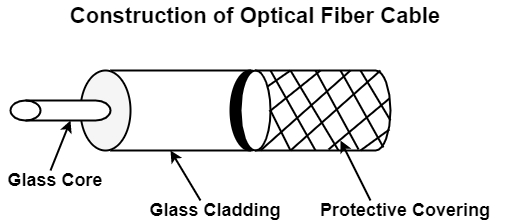
 Data Structure
Data Structure Networking
Networking RDBMS
RDBMS Operating System
Operating System Java
Java MS Excel
MS Excel iOS
iOS HTML
HTML CSS
CSS Android
Android Python
Python C Programming
C Programming C++
C++ C#
C# MongoDB
MongoDB MySQL
MySQL Javascript
Javascript PHP
PHP
- Selected Reading
- UPSC IAS Exams Notes
- Developer's Best Practices
- Questions and Answers
- Effective Resume Writing
- HR Interview Questions
- Computer Glossary
- Who is Who
What is Fibre Optic Cable?
A fibre optic cable is made of glass or plastic and transmits signals in the structure of light signals. The structure of an optical fibre cable is displayed in the figure. It involves an inner glass core surrounded by a glass cladding that reflects the light into the core. Each fibre is encircled by a plastic jacket.

In fibre optics, semiconductor lasers transmit data in the form of light along with hair-thin glass (optical) fibres at the speed of light (186,000 miles second) with no significant loss of intensity over very long distances. The system includes fibre optic cables that are made of tiny threads of glass or plastic.

Characteristics of Optical Fibre Cables
The main characteristics of Optical Fibre cables are as follows −
- Fibre optic cabling can support too high bandwidths in the range from 100 Mbps to 2 gigabytes because light has a much greater frequency than electricity.
- The several nodes that a fibre optic can provide does not rely upon its length but on the hub or hubs that linked cables.
- Fibre optic cable is not concerned by EMI effects and can be used in locations where high voltages pass.
- The value of fibre optic cable is more distinguished to twisted pair and co-axial.
- The setup of fibre optic cables is complex and endless.
Advantages of Optical Fibres
The advantage of optical fibre is as follows −
Small Size and lightweight − The size (diameter) of the optical fibres is minimal (comparable to the diameter of a human hair).
Easily available and low cost − The material used for producing the optical fibres is silica glass. This material is readily applicable. Therefore, the optical fibres cost lower than the cables with metallic conductors.
No electrical or electromagnetic interface − Since the transmission occurs in light rays, the signal is not affected by electrical or electromagnetic interference.
Large Bandwidth − As the light arrays have a very high frequency in the GHz range, the optical fibre bandwidth is vast. This allows the transmission of more numbers of channels. Therefore, the information-carrying capacity of an optical fibre is much higher than that of a Co-axial cable.
Disadvantages of Optical Fibres
The disadvantage of optical fibre are as follows −
High Cost − The cable and the interfaces are associatively more expensive than those of other guided media.
Unidirectional light propagation − Since the optical transmission is inherently unidirectional two-way communication requires either two fibres or two frequency bands on one fibre.
Installation and Maintenance − Fibre is different technology requiring skills; most engineers do not occupy.
It is defined as fixed point-to-point ground installations.

